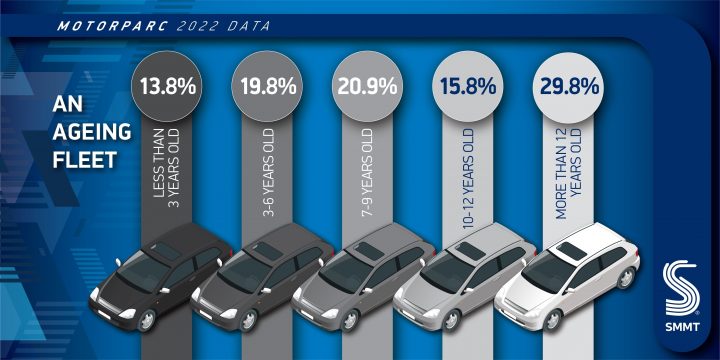More Britons are getting back into the driving seat following the pandemic, according to new annual Motorparc data from the Society of Motor Manufacturers and Traders.
However, the provision of public ev charge points has slowed and has not kept up with increasing registrations of PHEVs and BEVs.

The Moorparc data shows the number of cars in use on UK roads in 2022 rising by 124,393 units to a total of 35,148,045. This has returned the number of cars on the road to levels last seen in 2019, while the overall number of vehicles has risen to a record 40,723,974 units as supply shortages begin to ease and scrappage levels decline.
Businesses are also getting into gear to help deliver the UK’s post-pandemic recovery, with 615,570 trucks and 4,887,593 vans in service, up 1.9% and 1.7% respectively. Britain’s HGV parc is now at record levels, while vans make up almost one in eight vehicles in use, the largest proportion ever recorded.
The UK’s bus and coach fleet, however, has fallen again, by -2.3% to 72,766 vehicles – the lowest since records began, with 16,608 going out of service over the last decade.
More than one in four buses have been in use for more than 15 years, demonstrating the need for support to encourage operators to invest in the latest zero-emission buses given the essential role these vehicles play in providing mobility for millions of people and in road transport decarbonisation.
Despite the overall increase in vehicles on the road, average car and van CO2 emissions have fallen by -1.6% – driven by the influx of new lower and zero emission models. One in 32 cars driving in Britain now comes with a plug, amounting to 1,089,241 vehicles – a rise of more than half over the last year, to reach 3.1% of the parc.

Ownership of electric commercial vehicles has also risen, with vans up some 67.3% and buses and coaches increasing by 34.9%, while the number of zero emission trucks has almost trebled since last year – although they still account for fewer than one in 600 in use.
As a result, Britain is benefiting from a growth in vehicle numbers without compromising on the environment.
However, public charge-point rollout continues to lag behind EV uptake, with one standard public charger for every 36 plug-in cars on the road, down from 31 in 2021.
The need for investment is even more intense for other road transport sectors, however, as these existing chargepoints may not be suitably located or sized to serve van operators, and there are no dedicated HGV charging points on the UK’s strategic road network at all.
Deployment of infrastructure appropriate for commercial vehicles would energise uptake of the latest electric vehicles, accelerate fleet renewal to take older units off the road, and help reduce the UK’s carbon footprint.

Mike Hawes, SMMT Chief Executive, said, “After two tough years, Britain is on the road to recovery with the first growth in car ownership since the pandemic – while vans and trucks also continue to deliver for business and society in ever greater numbers.
“Better still, we are driving Britain towards a net zero future with more than a million zero emission vehicles now on the road and cutting carbon. With exciting new technologies and models fuelling our appetite to get back behind the wheel, now is the time to commit to greater investment in infrastructure and incentives, to speed up a switch to carbon-free mobility that is accessible to all.”


